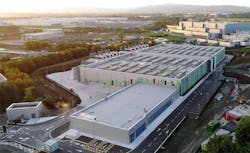Executive Insights: Phillip Marangella of EdgeConneX 2Q 2021
The Data Center Frontier Executive Roundtable features insights from industry executives with lengthy experience in the data center industry. Here’s a look at the insights from Phillip Marangella of EdgeConneX.
PHILLIP MARANGELLA, EdgeConneX
Currently serving as the Chief Marketing Officer at EdgeConneX, Phillip Marangella has over 20 years of international marketing, strategy, and business development experience working in the Data Center, Telecom and Technology sectors for leading service providers. Prior to joining EdgeConneX, Phillip most recently worked for Equinix in various capacities in both marketing and business development. In addition, Phillip had stints at Coresite, Verizon, MCI, Nortel and Globalstar. Phillip was also a partner and founder of a tech consulting firm focused on international technology transfer and venture funding of university developed technology. Currently serving as the Chief Marketing Officer at EdgeConneX, Phillip is focused on developing, evangelizing and executing the marketing strategy and ecosystem development for the company. Phillip also serves on the advisory boards for Apomaya and Infrastructure Masons. Phillip holds a Bachelors in Political Science from the University of California San Diego, and a Masters in Multinational Commerce from Boston University.
Here’s the full text of Phillip Marangella’s insights from our Executive Roundtable:
Data Center Frontier: What is the current state of data center rack density, and what lies ahead for cooling as more users put artificial intelligence to work in their applications?
Phillip Marangella: Rack density is affected by many factors, from the increasing use of GPU-based servers to an increased attention to the overall footprint of a data center and how that space can impact per-rack power numbers. What we know, however, is that rack density is consistently increasing and it’s one part of a larger effort by data center providers like EdgeConneX, where the topic of sustainability includes power generation, PUE, water usage, biodiversity at data center sites, emissions, and more.
Density is improving year over year, but power efficiency is, in some ways, more important. Power-efficient servers can mean more servers in a rack that requires less electricity to drive more processing power. We see more deployments taking place at the edge where the volume and velocity of data processing is frequently at its highest levels.
Data Center Frontier: Many industries are experiencing difficulty finding enough skilled workers. What’s the outlook for data center staffing, and what are the key strategies for finding talented staff?
Phillip Marangella: Staffing is definitely a challenge for the data center industry at large. However, we have a great opportunity to attract and recruit a younger, more diverse workforce. Some of things we have done to help improve our staffing challenges is to partner with firms like Salute, that takes and retrains skilled veterans to work in our data center environments.
Another initiative is something we curated in collaboration with the Infrastructure Masons. We created a Capstone project at Historically Black Colleges and Universities. In a pilot project last year at Hampton University in Virginia, scholarships to 12 students were provided for a year-long Digital Infrastructure focused project. We are looking to extend the program to 4 more HBCU’s this year and have plans to scale this internationally at some point in time as well.
Whether it’s retraining workers from other industries or teaching students and young workers about the various aspects of the data center business, a lot more needs to be done to drive awareness about our sector and the myriad of job opportunities that exist from engineering to security jobs, finance to design roles, or operations to real estate staff that are available at all companies in the digital infrastructure supply chain.
An example of a hyperscale data center developed by EdgeConneX. (Image: EdgeConneX)
Data Center Frontier: How have enterprise data center needs evolved during the pandemic? What do you expect for 2021?
Phillip Marangella: Like everyone, enterprises had to adapt during the pandemic, and one impact they saw was more investment in the digital transformation process, from remote workers to a heavier reliance on cloud-based services, and both a need and an opportunity for so many companies to compete globally. Data center providers saw these changes and responded with more choice, more flexibility, and more automation, enabling customers to manage their all of their deployments remotely via a single pane of glass.
We see these trends continuing and accelerating throughout the next 12 to 18 months as enterprises use more cloud and XaaS services and as they look for ways to expand their own markets and product portfolios. Data centers will be processing more workloads, more data, more video, more machine learning and serving as facilitators for a global transformation in business, even smaller or more regional enterprises. Data centers are becoming part of an infrastructure fabric of capacity, connectivity, power, and proximity that is empowering enterprises to take advantage of the location, the scale, and the economics that work for them.
“Data centers will be processing more workloads, more data, more video, more machine learning and serving as facilitators for a global transformation in business.”
Phillip Marangella, EdgeConneX
Data Center Frontier: Edge computing continues to be a hot topic. How is this sector evolving, and what use cases and applications are gaining the most traction with customers?
Phillip Marangella: Edge computing means so many different things to different businesses. For some, edge computing is a far edge deployment of small-footprint, purpose-built facilities that have very discrete needs. For others, it can mean IoT deployments in almost any industry – agriculture, automotive, aerospace, the list is literally endless. And for still others it can mean an intermediate processing point for connecting to the cloud.
Customers want to use the edge to get faster, more secure access to the cloud. They want to distribute content intelligently. They need interconnections to networks and proximity to an ecosystem of service providers that can help them succeed with cloud migrations and digital transformation projects.
The edge today is literally where you need it, when you need it, and at the scale you need for virtually any business. Our customers drive us to be more creative, responsive, and agile, and we empower our customers to be able to do whatever they need to do to push the boundaries of what’s possible for their businesses.

